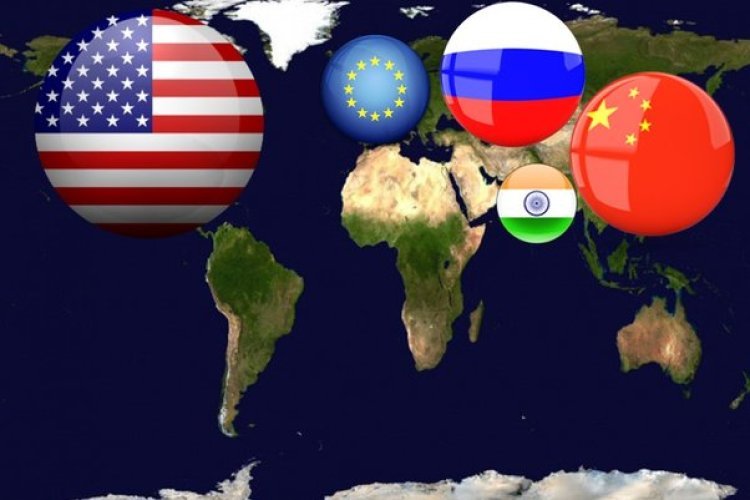
From Hegemon to Partner: The U.S. and the Tangled Road to Multipolarity
Posted in :
The U.S. is facing the erosion of its global dominance. Trump’s erratic diplomacy, rising global powers, and economic pressure are forcing a transition to a multipolar world—one the U.S. neither fully controls nor seems prepared for.
The unconventional shifts in U.S. foreign and economic policy highlighted in a podcast discussion with market analyst Alex Craner. Blending personal anecdotes, expert insights, and surprising analogies, it explores America’s departure from its postwar hegemonic playbook, the internal and external pressures driving policy change, and what a multipolar world could mean for both allies and adversaries.
Quick flashback: When this blogger first heard the word ‘multipolar’ tossed around at a family dinner, it got mistaken for a weather phenomenon. Yet now it’s everywhere, especially when talking about the U.S.’s evolving foreign policy under Trump. As market analyst Alex Craner suggests, we’re watching America attempt a high-wire act: shifting from a global hegemon to, well, something more ambiguous. Is this just a messy midlife crisis or a genuine strategy for the future? Let’s peel back the layers and dig in.
Shifting Sands: Beyond the Old World Order
The Post-WWII Blueprint: Outdated or Under Siege?
For decades, the world ran on a script written in Washington. After World War II, the U.S. offered generous trade deals to Western Europe. The idea? Build alliances, spread prosperity, and—let’s be honest—secure influence. It worked, for a while. But now, cracks are showing.
Some U.S. leaders are calling the old playbook “obsolete.” Senator Marco Rubio didn’t mince words:
“[The] global order is being used as a weapon against the United States.”
That’s a sharp turn from the optimism of the postwar years. Back then, America’s generosity wasn’t just charity. It was a strategic investment. The U.S. borrowed and spent, buying goods from allies and keeping the global engine running. But today, that model looks shaky—maybe even unsustainable.
America’s Generosity: A Worn-Out Strategy?
- Generosity for influence: The U.S. used to win friends by opening its wallet. Now, the bills are piling up.
- Debt dilemma: U.S. debt—both at home and abroad—has reached levels that make economists nervous.
- Changing tides: Rising powers, like China, are no longer content to play by old rules. They’re building their own alliances.
The world isn’t standing still. As America’s debts mount and its industries hollow out, other countries are stepping up. The U.S. once led in tech, banking, and currency. Now, those pillars seem less sturdy. The dollar’s dominance? Not quite what it used to be.
Internal Divides: Who Benefits from Empire?
Inside the U.S., another battle is brewing. It’s not just about foreign policy—it’s about who gains from the old order.
- The 99%: Many Americans feel left behind. Jobs shipped overseas, wages stagnating, and a sense that global deals only help the elite.
- The elite: A smaller group—corporate leaders, financiers, policymakers—have reaped the rewards of America’s global reach.
This tension is growing. Some want to pull back, focus on home. Others cling to the perks of empire—cheap goods, global influence, prestige. The Trump administration, for example, openly questioned “hegemonic” leadership. They argued for a reset, a shift away from costly global commitments.
Multipolarity: The New Reality?
As the U.S. debates its future, the rest of the world isn’t waiting. New power centers are rising. Multipolarity—a world with several influential nations, not just one top dog—is becoming the norm.
- China is building new trade routes.
- Europe is seeking more independence.
- Regional alliances are popping up everywhere.
The old order—built on American generosity and dominance—faces challenges from all sides. Some say the U.S. is “reaching the end of the line,” especially as others look for alternatives. The global script is being rewritten, and no one’s sure who’ll hold the pen next.
Multipolar Maneuvers: Trump’s Tightrope Between Russia, China, and Allies
Trump’s Multipolar Gamble: New Partners, Old Tensions
The Trump administration’s foreign policy has never fit the classic mold. Instead of clinging to old alliances, Trump seemed to eye a new world order—one where the U.S. is less a global policeman and more a strategic partner. But who are these new partners? The answer, for Trump, was obvious: Russia and China.
This approach, however, has put immense strain on traditional alliances. NATO members, European leaders, even some in Trump’s own party, have watched with unease as the U.S. recalibrates its priorities. The shift is not just a matter of rhetoric. It’s a fundamental change in how America sees its role in the world.
Two-Track Diplomacy: Deliberate or Disorganized?
Observers have often called Trump’s foreign policy “erratic” or “chaotic.” But is it really? Or is there a method to the madness? One insider put it bluntly:
‘Trump’s policies seem erratic and chaotic as they do because he can’t shoot straight.’
Yet, beneath the surface, there’s evidence of a deliberate two-track strategy. While General Kilog was dispatched to London, Kiev, Brussels, and Paris to reassure traditional allies, Trump’s confidant Steve Witkov held confidential talks with Russia. These weren’t just symbolic gestures. Real information was exchanged. Real lines were drawn.
- Official meetings with Western allies kept up appearances.
- Confidential talks with Russia explored new possibilities.
It’s a balancing act. Some would say it’s a tightrope walk over a diplomatic canyon.
Prioritizing Russia, Recalibrating China
Trump’s outreach to Vladimir Putin was no accident. Twice, he reached out directly. The relationship, according to those close to the talks, was “cordial and constructive.” What did they discuss? No one knows for sure. But the intent was clear: find common ground, even if it means leaving Ukraine and Europe to fend for themselves.
This shift has not gone unnoticed. Trump’s efforts to disengage from Ukraine have faced fierce resistance—not just from the media, but from Congress itself. Many in Washington, and across the Atlantic, want the U.S. to maintain its commitments. But Trump’s calculus is different. He’s looking at the numbers, the risks, the potential rewards.
‘Trump will accommodate Russia…’
That doesn’t mean sanctions are off the table. In fact, sanctions remain a point of contention. Congress, led by figures like Lindsey Graham, continues to push for tougher measures. Trump can veto, but only up to a point. The machinery of American foreign policy is complex. Not everything is under presidential control.
Stubborn Realities: Ukraine, Congress, and the Numbers
On the ground, the situation is grim. U.S. estimates put the kill ratio of Russian to Ukrainian soldiers somewhere between 1:10 and 1:20. It’s a staggering figure. For Moscow, this means there’s little urgency to negotiate as long as the status quo holds. For Washington, it’s a dilemma. Keep sending aid and prolong the conflict? Or step back and let Europe take the lead?
- Trump’s team tries to sell disengagement from Ukraine to the public and allies.
- Congress resists, pushing for continued military aid and sanctions.
- Russia, sensing advantage, waits.
Meanwhile, the China strategy is also being recalibrated. Less confrontation, more negotiation—at least in theory. But with so many moving parts, and so much resistance at home and abroad, nothing is ever simple.
Trump’s multipolar maneuvers may look messy. Maybe that’s the point. Or maybe, as some critics argue, he just can’t shoot straight.
Back to Basics: Reindustrialization, Debt, and Chasing Relevance
The United States, once the world’s ultimate consumer, is facing a turning point. For decades, the American economy thrived by borrowing from other nations to buy their goods. It was a cycle that seemed endless—until it wasn’t. Now, as global competition heats up and new markets emerge, that old model is showing cracks.
Shifting Gears: From Borrower to Builder
During the Trump era, a new vision took hold. The goal? To make the United States an “industrial powerhouse” again. No more relying on debt-fueled consumption. Instead, the focus shifted to producing and exporting—actually making things the world wants to buy. As one administration statement put it, “United States want to go back to being an industrial powerhouse.”
This isn’t just political rhetoric. It’s a response to a hard reality. The U.S. is now, as some put it, “eyeballs deep” in debt. And a significant chunk of that debt is owed to foreign creditors. The old way—borrowing to consume—just doesn’t add up anymore. It’s like maxing out a dozen credit cards to buy groceries, except with the world’s reserve currency and, well, nuclear weapons. Messy doesn’t even begin to cover it.
New Players, New Game
Meanwhile, the world is changing fast. The Global South—countries in Africa, Asia, and Latin America—is no longer just a source of cheap labor or raw materials. These regions are seeing real growth. According to the IMF and World Bank, 135 million new consumers joined the global economy last year. That’s a staggering number. It means new markets, new opportunities, and yes, new competition.
For American industry, this is both a challenge and an invitation. The days of the U.S. hoovering up everyone else’s products are fading. Now, there’s a race to capture the attention—and wallets—of these rising consumers. But the competition is fierce. Other countries are eyeing the same prize.
Rethinking Old Rivalries
There’s another twist. Russia, long seen as an adversary, is now being considered a potential resource partner. With vast reserves of energy and minerals, Russia could play a key role in a reindustrialized American economy. Even Vladimir Putin has signaled openness, stating the United States is “very welcome” as a partner. It’s a reminder that in this new era, yesterday’s enemies might become tomorrow’s collaborators.
The Road Ahead: Unfinished Business
So, where does this leave the United States? The push for reindustrialization is real, but the path is anything but clear. Competing in global markets requires more than slogans. It means investing in technology, rebuilding supply chains, and navigating a world where economic power is more spread out than ever.
Debt remains a looming shadow. The temptation to slip back into old habits is strong. But the numbers don’t lie. With hundreds of millions of new consumers worldwide, the stakes are higher than ever.
In the end, the U.S. faces a choice: double down on making things the world wants, or risk fading into irrelevance. The journey from hegemon to partner is messy, uncertain, and unfinished. But one thing is clear—the world is moving, and America can’t afford to stand still.
TL;DR: In a world where the U.S. can no longer write all the rules, adapting to a multipolar order is as chaotic as it is necessary – and no one (including Washington) seems to have a script. Strap in.
ReindustrializationAmerica, TrumpForeignPolicy, MultipolarIntegration, Russia-U.S.PolicyShift, U.S.GlobalOrder, GlobalEconomicRestructuring, GeopoliticalStrategyShifts, U.S.-ChinaRelations, AmericanDebtCrisis,multipolarity, U.S.foreignpolicy, globalpowershift, TrumpRussiaChina, Americanreindustrialization, post-hegemony, NATOrealignment, U.S.debt, globalsouth, economicrivalry
#GeopoliticalStrategyShifts, #U.S.-ChinaRelations, #TrumpForeignPolicy, #Russia-U.S.PolicyShift, #GlobalEconomicRestructuring, #U.S.GlobalOrder, #AmericanDebtCrisis, #ReindustrializationAmerica, #MultipolarIntegration,#Multipolarity, #USForeignPolicy, #TrumpDoctrine, #Geopolitics, #EconomicTransition, #RussiaChinaUS, #AmericanDecline, #NATO, #Reindustrialization, #GlobalSouth

